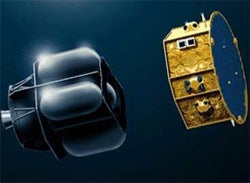One of Beyond Einstein’s flagship missions, the Laser Interferometer and Space Antenna, has seen some setbacks already. According to Jordan Camp, deputy project scientist for LISA at NASA’s Goddard Space Flight Center in Maryland, NASA’s new exploration vision has hit both LISA’s funding — the project’s 2005 budget was half of the $26 million expected — and its schedule, delaying launch to 2013 at the soonest.
However, a joint NASA and ESA mission designed to demonstrate LISA technology is fully funded by both partners. Called LISA Pathfinder, the spacecraft will fly two experiments, each using slightly different hardware, designed to reach about 10 percent of LISA’s sensitivity and control requirements.
ESA’s LISA Technology Package (LTP) contains an inertial sensor, a propulsion system, and control loop. A sensor monitors 2 identical masses, each a 46mm cube, in individual vacuum cans. Signals from the cubes’ motion with respect to their housing triggers the firing of microthrusters that keep the spacecraft centered on the masses. A laser interferometer monitors changes in the laser-beam length between the masses and compares them to a reference length. LTP is the most “LISA-like” of the two packages. In effect, LTP compresses one 3.1-million-mile (5 million kilometer) LISA arm into just 7.9 inches (20 centimeters).
The NASA experiment, called the Disturbance Reduction System, has the same mission goals as LTP, but uses slightly different sensor and propulsion technology. The spacecraft will fly centered on one of two cube-shape gravitational reference sensors, using the second as validation, while a laser interferometer compares the distance between cubes to a reference beam.
In June 2008, LISA Pathfinder will launch aboard an ESA booster into geostationary transfer orbit. Then, its own propulsion module will take the craft to its working orbit around the L1 gravitational balance point 930,000 miles (1.5 million km) sunward from Earth.










